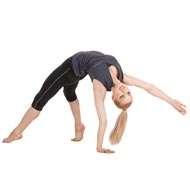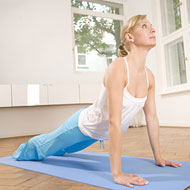Wild Thing (Camatkarasana)
If you want to include something new into your practice of yoga, you could try your hand at the Wild thing (Camatkarasana). This pose encourages you to grow your roots into the earth and also as you stretch your back, to offer your heart as a present to the heavens.
Before you try the wild thing yoga pose you should make sure that there is sufficient room around you.
Steps :
- You should begin this pose by performing the Adho Mukha Svanasana (Downward facing dog).
- Slowly transfer your weight onto your right hand and onto the outer part of your right foot as if you are performing the Vasisthasana (Side plank pose).
- While breathing in, allow your hips to be lifted as if filled with buoyancy. Your right hand should stay strong with the fingers making a claw. The head of the bone of the right arm should be kept back. While breathing out, move your left foot back and place your toes on the ground with your knee slightly bent.
- Curl your upper back so that the shoulder blades make a sweeping action to the back part of the ribs.
- While breathing in, lift your hips higher till you are curled into a backbend and your right foot is stable on the ground.
- As you continue breathing, your head should be dropped back and your left arm extended from your heart expressing your freedom and power.
- Remain in this position for around 5 to 10 breaths and repeat the wild thing steps for the other side.
Precautions :
- Avoide this posture if you suffer from high blood pressure, migraine, or headaches.
- This posture is also not advised if you are recovering from a hernia or heart attack.
- There is also some stress placed on the wrist and shoulder of the arm bearing the weight. Hence, you should avoid this posture if your wrists or shoulders are weak.
- You should also exercise with caution when performing this posture if you have a sore neck.
Beginner’s Tip :
A useful beginner’s tip For Wild thing is that while the pose is being performed, it should never become painful. It is also important for beginners to practice under the guidance of a qualified instructor since performing the posture in an incorrect manner will result in injury. You should consult your doctor if you have any health concerns or questions regarding your ability to perform the pose.
Benefit To Body Part :
- The Camatkarasana opens up the shoulderss, lungs, and chest.
- It also opens the hip flexors and the front of the legs.
- It builds strength in the upper back and shoulders.
- Along with the benefit to body parts it also helps improve the circulation of blood to the organs.
Therapeutic Applications
- One of the therapeutic applications of Camatkarasana pose is its effectiveness in helping to deal with fatigue.
- It is also effective for the treatment of mild depression.
Variations :
Variations for Wild thing can be performed by individuals who are restricted from doing this pose due to certain conditions. This pose can be done in a standing position for people with weak shoulders or wrists or for those who don’t have sufficient body strength.
Preparatory Poses :
- Side Plank Pose (Vasisthasana)
- Bow Pose(Dhanurasana).
- Downward-Facing Dog (Adho Mukha Svanasana)
Follow Up Poses :
- Child's Pose(Balasana).
- Downward-Facing Dog (Adho Mukha Svanasana)



